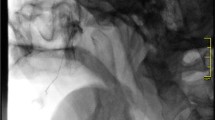Abstract
Purpose
In this study, we aimed to examine and compare the effects of endoscopic SPGB and transoral SPGB on postoperative pain control and patient satisfaction in patients undergoing septoplasty.
Methods
Participants were randomly divided into three groups, no blockade (n:20), endoscopic SPGB (n:20), and transoral SPGB (n:20). Those who had no blockage were included in the control group. Demographic data of patients, such as age and sex, VAS (visual analogue scale) and postoperative pain scores (PPS) [determined at arrival in the post-anesthesia care unit (PACU) and after 2, 6, 12, and 24 h], general analgesic use (24 and 168 h after surgery) and postoperative Quality of Recovery (QoR-15) values were recorded and compare them.
Results
The PPS PACU of 2 h, 6 h, 12 h, and 24-h values of the transoral group were lower than the endoscopic and control groups (p < 0.001).The values of 24 h and 168 h of analgesic use in the transoral group were lower than in the control and endoscopic groups (p < 0.001).The average recovery QoR-15 scores at 12 h and 24 h differed according to the groups (p < 0.001) and the highest values were in the transoral group (p < 0.001).
Conclusion
Transoral SPGB is more effective in postoperative pain control than endoscopic SPGB, it decreases the use of postoperative analgesics and improves postoperative recovery scores.
Similar content being viewed by others
Data availability
Not applicable.
References
Nguyen BK, Yuhan BT, Folbe E, Eloy JA, Zuliani GF, Hsueh WD, Paskhover B, Folbe AJ, Svider PF (2019) Perioperative analgesia for patients undergoing septoplasty and rhinoplasty: an evidence-based review. Laryngoscope 129(6):E200–E212. https://doi.org/10.1002/lary.27616
Robbins MS, Robertson CE, Kaplan E, Ailani J, Charleston L 4th, Kuruvilla D, Blumenfeld A, Berliner R, Rosen NL, Duarte R, Vidwan J, Halker RB, Gill N, Ashkenazi A (2016) The sphenopalatine ganglion: anatomy, pathophysiology, and therapeutic targeting in headache. Headache 56(2):240–258. https://doi.org/10.1111/head.12729
Alexander CE, Dua A. Sphenopalatine Ganglion Block. In: StatPearls. Treasure Island (FL): StatPearls Publishing; November 16, 2022.
Kesimci, E., Öztürk, L., Bercin, S., Kırış, M., Eldem, A., & Kanbak, O. (2012). Role of sphenopalatine ganglion block for postoperative analgesia after functional endoscopic sinus surgery. European archives of oto-rhino-laryngology : official journal of the European Federation of Oto-Rhino-Laryngological Societies (EUFOS) : affiliated with the German Society for Oto-Rhino-Laryngology - Head and Neck Surgery, 269(1), 165–169. https://doi.org/10.1007/s00405-011-1702-z
Fujiwara, T., Kuriyama, A., Kato, Y., Fukuoka, T., & Ota, E. (2018). Perioperative local anaesthesia for reducing pain following septal surgery. The Cochrane database of systematic reviews, 8(8), CD012047. https://doi.org/10.1002/14651858.CD012047.pub2
Cho DY, Drover DR, Nekhendzy V, Butwick AJ, Collins J, Hwang PH (2011) The effectiveness of preemptive sphenopalatine ganglion block on postoperative pain and functional outcomes after functional endoscopic sinus surgery. International forum of allergy & rhinology 1(3):212–218. https://doi.org/10.1002/alr.20040
Kara U, Şimşek F, Kamburoğlu H, Özhan MÖ, Alakuş Ü, İnce ME, Eksert S, Özkan G, Eşkin MB, Şenkal S (2022) Linguistic validation of a widely used recovery score: quality of recovery-15 (QoR-15). Turk J Med Sci 52(2):427–435. https://doi.org/10.55730/1300-0144.5330
Ekici NY, Alagöz S (2019) The effectiveness of endoscopic sphenopalatine ganglion block in management of postoperative pain after septal surgery. Int Forum Allergy Rhinol 9(12):1521–1525. https://doi.org/10.1002/alr.22411
Al-Qudah M (2016) Endoscopic sphenopalatine ganglion blockade efficacy in pain control after endoscopic sinus surgery. Int Forum Allergy Rhinol 6(3):334–338. https://doi.org/10.1002/alr.21644
Most SP, Rudy SF (2017) Septoplasty: Basic and Advanced Techniques. Facial Plast Surg Clin N Am 25(2):161–169. https://doi.org/10.1016/j.fsc.2016.12.002
DeMaria S Jr, Govindaraj S, Chinosorvatana N, Kang S, Levine AI (2012) Bilateral sphenopalatine ganglion blockade improves postoperative analgesia after endoscopic sinus surgery. Am J Rhinol Allergy 26(1):e23–e27. https://doi.org/10.2500/ajra.2012.26.3709
Ho KWD, Przkora R, Kumar S (2017) Sphenopalatine ganglion: block, radiofrequency ablation and neurostimulation - a systematic review. J Headache Pain 18(1):118. https://doi.org/10.1186/s10194-017-0826-y
Rezaeian, A., Hashemi, S. M., & Dokhanchi, Z. S. (2019). Effect of Sphenopalatine Ganglion Block With Bupivacaine on Postoperative Pain in Patients Undergoing Endoscopic Sinus Surgery. Allergy & rhinology (Providence, R.I.), 10, 2152656718821282. https://doi.org/10.1177/2152656718821282
Author information
Authors and Affiliations
Contributions
AK, SOE and NYE is an otorhinolaryngology specialist in the Adana City Education and Research Hospital. Both researches currently focuses on voice disorders, head and neck malignities and obstructive sleep apnea.
Corresponding author
Ethics declarations
Conflict of interest
The authors declare that they have no conflict of interest.
Ethical approval
All procedures performed in this study involving human participants were conducted in accordance with the ethical standards of the institutional research committee and with the 1964 Helsinki Declaration and its later amendments comparable ethical standards. The study was approved by the institutional ethics committee. This article does not contain any studies with animals performed by any of the authors.
Informed consent
Informed consent was obtained from all individual participants included in the study.
Additional information
Publisher's Note
Springer Nature remains neutral with regard to jurisdictional claims in published maps and institutional affiliations.
Rights and permissions
Springer Nature or its licensor (e.g. a society or other partner) holds exclusive rights to this article under a publishing agreement with the author(s) or other rightsholder(s); author self-archiving of the accepted manuscript version of this article is solely governed by the terms of such publishing agreement and applicable law.
About this article
Cite this article
Karaoğullarından, A., Erkan, S.O. & Ekici, N.Y. Is transoral sphenopalatine ganglion blockade more effective on postoperative pain than endoscopic sphenopalatine ganglion blockade?. Eur Arch Otorhinolaryngol 281, 193–199 (2024). https://doi.org/10.1007/s00405-023-08174-8
Received:
Accepted:
Published:
Issue Date:
DOI: https://doi.org/10.1007/s00405-023-08174-8




